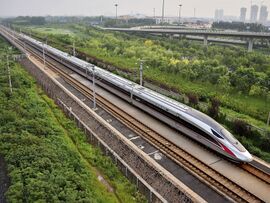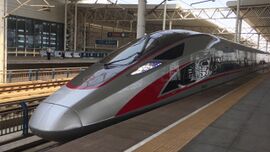Zhenia National Express: Difference between revisions
No edit summary |
No edit summary |
||
| Line 35: | Line 35: | ||
==History== | ==History== | ||
Initial plans for a high-speed train in Zhenia emerged as early as the 1930s, when the existing passenger rail services, particularly those within the [[Danguk Peninsula]] and the Golden Arc was facing congestion and was expected to be unable to catch up ever-increasing demand. Express services stopping in fewer stations along the Gulf and the Peninsula were operated, while existing rail lines, particularly the Danguk Peninsula and the Gulf lines, were expanded and newer, faster locomotives were being used in priority passenger services. Parallel to improvements on existing infrastructure, a fundamentally new solution of building lines of electrically-powered trains, as opposed to using diesel locomotives, were devised as well. The Second Great War, however, halted the idea beyond initial development, and the idea was forgotten until its resurfacing during the economic resurgence of the Third Republic. | |||
In 1958, seeing that numerous existing rails were operating well beyond design capacity due to increases in both passenger and cargo demand, the newly-established ZhenRail called for a completely newly-built, {{wp|electrification|electrified}} railway supplementing existing passenger rail services. Although many proposals regarding this were made, the finalized proposal would include a network of completely new routes designed exclusively for such high-speed electric trains, with the hope that existing steam and locomotives will ultimately be superseded by speed. The proposal gained approval from [[Kim Shimin]] in 1959, the same year the routes were finalized and land acquisition began. | |||
The first route built at the time was the Donggyeong-Changan route, the conventional rails of which had been congested with both industrial and passenger demand by then. Construction in the Donggyeong-Changan line became an exemplary case for all future construction of ZNX routes. While some were built directly on level surfaces on land, most of the initial segment was built on viaducts, bridges and tunnels. Although initially unplanned, the task to upgrade and electrify existing conventional railways were also added to the plan, as it was anticipated that the new high-speed rail might have to run on conventional tracks in the worst of circumstances. Most tracks in urban areas were built at least 20 meters below the surface, in order to minimize contact with existing rail services. | |||
==Railway Network== | ==Railway Network== | ||
Revision as of 20:53, 24 November 2019
 | |
| Dates of operation | 1974–Present |
|---|---|
| Track gauge | 1,435 mm (4 ft 8 1⁄2 in) Standard gauge |
| Headquarters | Changan, Zhenia |
| Website | www.znx.zhen |
The Zhenia National Express (Zhenian: 진국고속철도), commonly stylized as ZNX, is Zhenia's intercity high-speed rail network operated by the ZhenRail. It was constructed to connect major population centers located in both mainland Zhenia and the Danguk Peninsula, as well as linking major cities and distant segments of the Golden Arc region to Donggyeong in order to revitalize passenger transport via rail. With a length of almost 20,000 kilometers as of 2019, it is one of the most extensive high-speed rail networks in the world.
Construction of high-speed lines in Zhenia began in the mid-1960s, with the first lines, the Donggyeong-Changan line, commencing service in March 1, 1974. Further developments resulted in the completion of the Trans Golden Arc line in 1984, the Shinhang-Ariul line in 1989 and later other developments, ultimately resulting in 94% of Zhenians living within 100 kilometers from their nearest high-speed rail station. ZhenRail currently defines the term "high-speed railway" as any line capable of passenger services at or exceeding 250 km/h on its routes.
The maximum speed for trains in regular service is at 400 km/h, although signal and infrastructure systems allow for a theoretical maximum speed of 430 km/h. While initial trains operated at speeds around 240 km/h, later EMU trains brought up the average speed to around 350 km/h. Maglev trains fitted with linear motors, estimated to have a maximum speed of over 500 km/h, are currently under testing in the Donggyeong-Changan line as of 2019, with the first units expected to enter service in 2025.
History
Initial plans for a high-speed train in Zhenia emerged as early as the 1930s, when the existing passenger rail services, particularly those within the Danguk Peninsula and the Golden Arc was facing congestion and was expected to be unable to catch up ever-increasing demand. Express services stopping in fewer stations along the Gulf and the Peninsula were operated, while existing rail lines, particularly the Danguk Peninsula and the Gulf lines, were expanded and newer, faster locomotives were being used in priority passenger services. Parallel to improvements on existing infrastructure, a fundamentally new solution of building lines of electrically-powered trains, as opposed to using diesel locomotives, were devised as well. The Second Great War, however, halted the idea beyond initial development, and the idea was forgotten until its resurfacing during the economic resurgence of the Third Republic.
In 1958, seeing that numerous existing rails were operating well beyond design capacity due to increases in both passenger and cargo demand, the newly-established ZhenRail called for a completely newly-built, electrified railway supplementing existing passenger rail services. Although many proposals regarding this were made, the finalized proposal would include a network of completely new routes designed exclusively for such high-speed electric trains, with the hope that existing steam and locomotives will ultimately be superseded by speed. The proposal gained approval from Kim Shimin in 1959, the same year the routes were finalized and land acquisition began.
The first route built at the time was the Donggyeong-Changan route, the conventional rails of which had been congested with both industrial and passenger demand by then. Construction in the Donggyeong-Changan line became an exemplary case for all future construction of ZNX routes. While some were built directly on level surfaces on land, most of the initial segment was built on viaducts, bridges and tunnels. Although initially unplanned, the task to upgrade and electrify existing conventional railways were also added to the plan, as it was anticipated that the new high-speed rail might have to run on conventional tracks in the worst of circumstances. Most tracks in urban areas were built at least 20 meters below the surface, in order to minimize contact with existing rail services.

